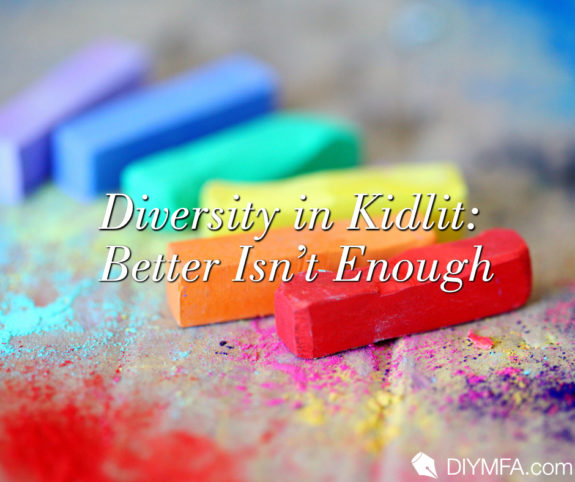I’ve recently written about disparity in YA publishing and how it reflects broader trends in publishing generally in my column “Is this a YA thing?”: On Pay Rates, Racism, and Toxicity in Publishing. Now I am tackling a problem in kidlit. We need better DEI: Diversity, Equity, and Inclusion.
This problem is not unique to kidlit. Traditional publishing is an inherently political industry. It amplifies certain voices and narratives, and not others, which is a political choice. You’re chosen, or you’re not. Your perspective is valued and shared widely, or it’s not.
As this column has discussed before, young readers are particularly sensitive and vulnerable to negative depictions of themselves and others in books. It’s imperative that books for kids be welcoming and inclusive. That’s why we need to talk about DEI in kidlit publishing.
You may be under the impression that these issues are better in kidlit than in other areas of publishing. You may be aware of data like The Ripped Bodice’s survey of diversity in romance publishing, which shows dismal numbers, and contrast it with the existence of organizations like We Need Diverse Books, which specializes in children’s’ publishing and advocates for wider inclusion. You might want to pat kidlit on the back and say, “Great job being better than those other genres and categories!”
Here’s the thing… better does not mean good.
More and more visible work has been done to broaden kidlit. There have been slight improvements, but still way, way too far left to go.
Where We Stand
The Cooperative Children’s Book Center (CCBC) at the University of Wisconsin-Madison has been assessing diversity statistics in children’s books since 1985. Each year they “receive most but not all trade books published by the ‘Big 5,’ as well as books from some smaller trade houses, smaller independent presses, and self-published books.” The books are primarily from the US, but they do receive some from other English-speaking nations. The CCBC determines if a book was by a BIPOC (Black, Indigenous, and People of Color) author, and if the major characters featured in the book are BIPOC.
The CCBC survey primarily focuses on race every year, but has done some work around LGBTQ+ books and authors. It’s also important to note that how they defined BIPOC varied over the years. For instance, there are statistics for Black authors going back to 1985, but Latinx statistics only go back to 1994. They continue to expand the categories over time.
You can find raw numbers here. Also, here is a more detailed analysis of 2019, which is the most recent data available.
The infographics below illustrate the proportionate distribution of books depicting BIPOC characters in a given year.
2012 – Only 7% BIPOC
Original Graphic via CCBC illustrating 2012 Statistics || Tina Kügler, Illustrator, https://tinakugler.squarespace.com/
Of the 3,600 books CCBC received in 2012, 3,329 were primarily about white characters.
Houston, we have a major problem.
2015 – Slightly More BIPOC than Animals
In 2015, BIPOC made up 14.2% of the 3,400 books CCBC received. To quote the infographic, “About a quarter of the total children’s books published in 2015 were picture books, and about half of those depict non-human characters like animals & trucks. … The remainder depict white characters.”
Houston, I smell smoke. Like a lot of smoke.
2018 – More Animals than BIPOC
In 2018 CCBC received 3,653 books, half of which were about white characters. That’s quite a decrease from 2012, no? But: across these three graphics we can see that when the percentage of white characters decreases they are primarily replaced by animals and other non-human characters–not by BIPOC characters.
Houston, the wing is on fire.
2019 – “Alternatives” Continue
Data from 2019 was released in June 2020 and there’s no infographic for this year (thanks, COVID!). This year’s data drew from 3,716 books, and was broken down into a few extra categories, most notably “Brown Skin.”
From the blog post: “‘Brown skin’ indicates books in which the primary character clearly has brown skin (indicated by illustrations or text), but there are no specific racial or cultural signifiers in the illustrations or text.” This is problematic because it lumps all brown-skinned characters into an undifferentiated mass.
The decrease in white characters between 2018 and 2019 is 8.2%. Which is handily exceeded by the “Brown Skin” category at 9.2%. As with the Animal/Non-Human trend, we see between 2018 and 2019 that published books would rather give space to vaguely “Brown Skin” characters than give BIPOC characters actual identities.
Mayday, Houston, mayday!
The Lost Books
Reflection Press is a small publisher focused on diversifying children’s lit. They used CCBC’s 2017 data to do their own infographics and analysis, which you can read in full here.
Their work compares the character breakdowns to the US population’s racial makeup. For instance, African Americans make up 13% of the US population, but were only 3.3% of characters that year.
Then they calculated how many books would have to be published featuring African American characters to fill that gap between the population and the represented characters. In 2017 it would’ve taken 524 books to bring about parity!
They ran these numbers using CCBC’s data for the last 12 years, and reckon we’re missing some 6,000 books that should have featured African American major characters.
Who’s Writing Whom?
But it’s not enough to look at the characters. We also need to look at the authors.
In 2019, CCBC determined that 11.9% of books featured African American major characters. But of the 3,716 books received, only 5.8% were written by African Americans. Less than half of all books featuring Black characters are written by Black authors.
The characters are fictional. The authors are real people. These authors have a tiny fraction of the publishing landscape, and as we saw with #PublishingPaidMe, they aren’t treated fairly even when included.
What do we do now, Houston?
A recent academic study titled “Rethinking ‘Diversity’ in Publishing”, which focused on kidlit, genre, and literary fiction in the UK (which has its own diversity problems!) assessed how diverse authors and books are handled throughout the publishing process. They interviewed everyone: authors, agents, editors, publishers, book sellers, and so on. And they had some recommendations about how to support these books and authors.
Publishing professionals need to question their biases, reckon with the privileges they have within the industry, and not only open up space but truly provide support by giving institutional resources–especially money–to the people doing this work. The system needs to demonstrate where its values lie through resources.
We need to build a more fair industry through anti-racist work. It’s especially important that we do this within kidlit where our readers are having formative experiences through books.

Bronwen Fleetwood writes fiction for young adults, and nonfiction for writers. Bronwen studied creative writing at Eugene Lang,The New School for Liberal Arts, has acted as leader of the Princeton Writing Group, and as a Municipal Liaison for National Novel Writing Month. Bronwen currently lives on the Whale Coast of South Africa, between the mountains, the sea, and a lake. You can connect with her at bronwenfleetwood.com.







